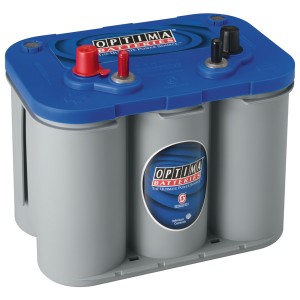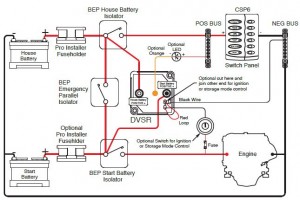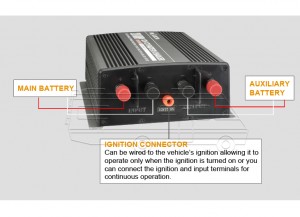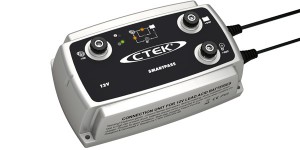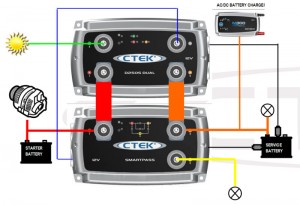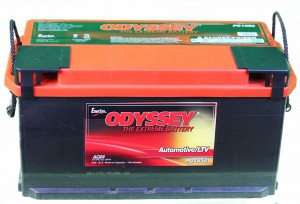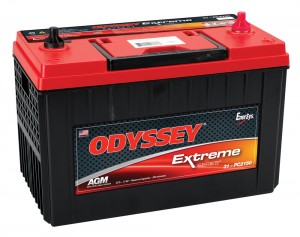OK, I have been talking about power solutions for quite some time now and my first twin battery set-up was in the early 80’s and things have changed a lot since then. As a rule adding a small amplifier to your system generally wont be a problem and using your existing battery in the short term should not be an issue, but still I would recommend upgrading as a starting point and adding more batteries as required as your systems needs grow… 🙂
A great first option would be a Optima D34M
As your systems needs, increase, you can add another battery to the system, now this is where things get interesting. How do we connect and charge additional batteries? Right see below for low to high cost options…
Option 1/ DVSR – Digital Voltage Sensitive Relay
Charging – The DVSR is connected between two battery banks. When the DVSR senses a charging voltage (13.4DVC) on either of the banks, it automatically activates and joins the two battery banks after a short delay (5 seconds), so they are charged as one battery bank.
Isolation – When the DVSR senses that batteries are not being charged (voltage drops to 12.8v) the DVSR deactivates following a 20 second delay, separating the combined battery banks into two isolated banks.
Option 2/ Projecta DC20 3 Stage Automatic 12V to 12V 20A Battery Charger
The DC20 charger overcomes the problem of voltage drop associated with long cables commonly used with auxiliary battery installations. By “stepping up” the dropped voltage using switchmode charging technology, the DC20 delivers a full three stage charge to your auxiliary battery.
Switchmode Technology – Using the latest switchmode technology, the DC20 converts your vehicle’s 12VDC alternator power up to 14.4VDC allowing your batteries to be fully charged, prolonging battery like and reliability. Switchmode charging uses electronic components allowing the charger to be lightweight and compact without sacrificing on performance.
Superior 3 Stage Charging – Using electronic control, the charger delivers 3 stage charging resulting in a faster and more powerful charge, making it ideal for deep cycle batteries. The first stage, bulk (constant current), charges the battery faster while the second stage , absorption (constant voltage), ensures the battery is thoroughly charged. The final stage, float, maintains the battery at a safe voltage allowing it to be maintained and ready for use indefinitely.
Option 3/ CTEK D250S Dual Fully Automatic 5-Stage Smart Charger
The D250S DUAL charger obtains its energy from DC sources such as alternators, solar panels or wind power and optimises this power to meet the charging requirements of different battery banks. The D250S DUAL automatically selects the best connected DC energy source (of 2) for the purpose and switches between these energy sources to achieve high efficiency multi-stage charging. The D250S DUAL is particularly suitable for charging caravans, motor caravans, boats and second homes that do not have access to grid power supplies. Charging automatically starts as soon as DC energy is provided to the charger, such as from alternators when a vehicle is started or from solar panels when connected. The D250S DUAL has a temperature sensor which ensures optimal charging voltages at all temperatures. The D250S DUAL ensures that your batteries are always in good condition, quick charging and long battery lifetimes.
The D250S DUAL is a fully automatic 5-stage charger that supplies 20A to 12V batteries of 40-300Ah. The charger is IP65 classified (water jet and dust protected and approved for outdoor use), protects vehicle electronics and is suitable for all types of lead-acid batteries (Wet, MF, Gel, AGM).
Option 4/ CTEK SmartPass Energy Management Unit
SmartPass is an energy management unit which controls and optimises energy produced by alternators, solar cells, wind power or conventional AC/DC chargers, and distributes it to the battery banks or consumers which require energy, such as the deep cycle bank, bow thruster batteries, consumers, etc. Used together with a D250S, SmartPass provides optimal charging via CTEK’s unique staged charging cycle, which also protects your batteries. SmartPass also has an integrated “battery guard” which protects deep cycle batteries from harmful total discharge and ensures that critical equipment such as radio, emergency lights and navigation systems always function. SmartPass has a temperature sensor which protects batteries against high temperatures.
SmartPass is a fully automatic energy management system which can handle up to 80A for batteries of between 28-800Ah. The energy management system is IP65 classified (water jet and dust protected and approved for outdoor use). Suitable for all types of 12V lead-acid batteries.
Of course there are limits to what we can and cannot do and options 3 and 4 other battery options like high end Odyssey Batteries
Odyssey PC1350 Battery AGM 95AH
Odyssey PC2150 Marine G31 100AH
Battery Power is hugely important and the charging of them is a must, as we play with larger systems, ie; multiple amplifiers, then the vehicles power system must be very robust and able to cope with the demands we put on it.
See below a very important information in battery management, quantity of batteries, multiple battery limits…
Never connect more than 3 batteries in Parallel – the reason for this is twofold.
1. 12 volt batteries are made of 6 x 2 volt cells. If one cell in one of the battery dies the voltage will still appear to be 12 volt because of the parallel batteries (but capacity will be reduced). Alternatively if it’s a single battery string the battery will appear as being very flat. This is where a switch mode charger is essential to detecting the fault and not allowing the charge to continue. But with one cell now gone the 2.45 volts the charger was apply to all cells equally that cell voltage is now diverted to the remaining cells of the string. So 2.45 divided by 5 remaining cells is an extra 0.49 volt per cell on top of the already upper limit of 2.45 volts each. This is like charging a 12 volt battery at 17.6 volts.
2. Equalisation becomes an issue with multiple batteries connected in Parallel. Energy flows through the path of least resistance so if that’s in and out of the first battery and not through the paralleled batteries then that’s what it will do. The 2nd and 3rd batteries will not give as much energy as the first nor will they receive a fair share of the in current to recharge. So overtime the balance between 1st battery and additionally attached batteries grows and the systems voltage starts to show this difference. If checked individually. If left connected and charged the flat battery never reaches full charge because the other batteries that were already charged are now overcharged hence the higher voltage and gassing, but that also offsets the undercharged battery so both will fail within 6 months if used daily or 2 years if used a few times a week. (if you abuse the batteries but don’t discharge them that often and you do recharge them for say 30 Mins a day in a vehicle, you’d probably say the brand of batteries you use has been fantastic, but really you haven’t used the cycle life so the damage is done but you can’t see the outcome yet. Somebody else might use the same battery but not drive the same 30 Mins and they’ve had to replace them after 18 months. Both situations are incorrectly sized and specifications but it’s not the battery brands fault for the two different outcomes.
Batteries need to be charged using the one tenth rule. Use current to recharge a battery which is equal to one tenth the batteries capacity to achieve a full recharge from flat within a 12 hour period.
An 80 Amp battery charger could recharge an 800AH battery bank if you could leave it to charge for 12 hours. This isn’t usually possible in NZ as you can drive top to bottom of each island in 12 hours so while the 80A could charge up to 800AH it’s more likely to be useful for charging 400AH over 4 hours and be 90% recharged. A maintenance charger could easily finish off the remaining 10% overnight in the garage.
A 1100 CCA battery is rated to provide that amount of power for 30 seconds until the battery voltage is 7.2 volts. The catch is it does this at minus 18 deg C. At zero degrees C the capacity doubles so it could last for 60 seconds. The PHCA is a peak power output for 5 seconds. On Odyssey PC2150 is 2150 Amps for 5 seconds. Or something like 1000 amps for 60 seconds.
The quicker the energy is discharge from a battery the less time it can maintain this high output. Ie. 100 AH battery at 20 hour rate is 5 amps per hour for 20 hours totalling 100AH. But if you wanted to discharge all that batteries energy as quickly as possible you could discharge 64 amps for 1 hour. Both these would of discharged all the energy within the battery to 100% depth of discharge at 10.5 Volts.
If you are discharging 1000 amps (12800 watts) then the depth of discharge is quite high (even over 30 seconds) and the batteries for best results should be recharged as soon as possible after use. You can estimate the depth of discharge by stopping all discharging loads and letting the battery rest for 2 hours and then checking the voltage. See State of Charge (SOC) table for info on depth of discharged state. So you can calculate how many times you can discharge at this rate before requiring a full recharge. As mentioned before it’s best to recharge ASAP for good battery health.
One thing left that’s a must (FUSES)
We have a big range of fuse options starting from 30 amp through to 500 amp again ask us we are here to help.
Like to know more?? see link below…
http://abtec.co.nz/Installation_Products_Power_Solutions
contact myself or Barry our Power Solutions specialist on 0800 10 10 81
Ashley Madd Bass Burrell


